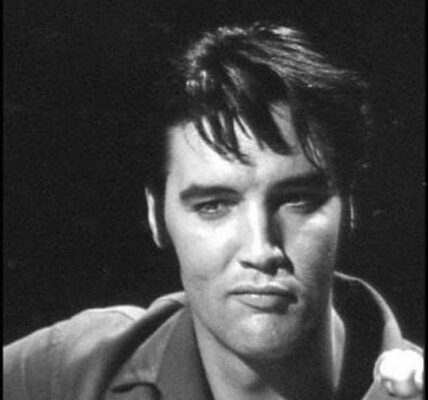Explore Elvis’s Youthful Energy and Musical Journey with “Money Honey”: Let the King’s Rock and Roll Spirit Take You on a Ride.0h
Elvis Presley’s “Money Honey” isn’t a chart-topping ballad or a hip-shaking rockabilly anthem. Instead, it’s a gritty slice of rhythm and blues, showcasing the King’s early exploration of different musical styles and his undeniable connection to the genre’s roots. Released in 1956 on his self-titled debut album, the song stands as a testament to his versatility and his ability to infuse familiar sounds with his own electrifying energy.

Composed by Jesse Stone, “Money Honey” wasn’t originally written for Elvis. The song first hit the airwaves in 1953, performed by Clyde McPhatter and The Drifters. It quickly rose to success, becoming a number one hit on the R&B charts. This widespread popularity likely caught Elvis’ ear, already drawn to the bluesy undercurrents of popular music.

When Elvis entered the Sun Studio in January 1956, “Money Honey” was part of the planned recording session. His version, however, differed significantly from the original. Elvis injected a faster tempo, adding a driving drumbeat and Scotty Moore’s distinctive guitar licks. His vocals, brimming with youthful swagger and playful charm, breathed new life into the song, transforming it into an electrifying rock and roll number with strong R&B roots.

While never released as a single, “Money Honey” found its audience on Elvis’ debut album. The song’s raw energy and infectious sound resonated with listeners, solidifying its place as a live favorite. In his electrifying performances, Elvis often extended the song, improvising lyrics and engaging in playful interactions with the band, further showcasing his stage presence and musical prowess.

Today, “Money Honey” might not be as widely recognized as some of Elvis’ other hits, but its significance within his discography remains undeniable. It represents his early exploration of R&B influences, his ability to transform existing material into something uniquely his own, and his electrifying presence that ignited audiences with every performance. So, if you’re looking for a glimpse into the raw energy and musical journey of the young Elvis, dive into “Money Honey” and let the King’s bluesy rock and roll spirit take hold.
Video:
Elvis Aaron Presley, often referred to as the “King of Rock and Roll,” was born on January 8, 1935, in Tupelo, Mississippi, USA. He rose to prominence in the mid-1950s, becoming one of the most iconic and influential figures in the history of popular music. Presley’s musical journey began at an early age when he started singing in church and listening to various genres of music, including gospel, blues, and country. In 1954, he signed a recording contract with Sun Records, where he began his career blending elements of rockabilly, rhythm and blues, and country music. His breakthrough came with the release of his first single, “That’s All Right,” followed by a string of hits such as “Heartbreak Hotel,” “Hound Dog,” and “Jailhouse Rock.” With his charismatic stage presence, distinctive voice, and provocative dance moves, Presley captured the hearts of audiences worldwide, revolutionizing the music industry and popular culture. Presley’s impact extended beyond music; he also found success as an actor, starring in a series of films throughout the 1960s. Despite his commercial success, he faced criticism from some quarters for his crossover into mainstream entertainment and the perceived dilution of his musical authenticity. Throughout his career, Presley struggled with the pressures of fame, leading to personal challenges, including substance abuse and health issues. Despite these obstacles, he remained a beloved figure, revered for his contributions to music and his enduring legacy. Tragically, Elvis Presley passed away on August 16, 1977, at the age of 42, leaving behind a legacy that continues to resonate with generations of fans. He was posthumously inducted into the Rock and Roll Hall of Fame, and his music remains a timeless testament to his enduring talent and cultural impact.

